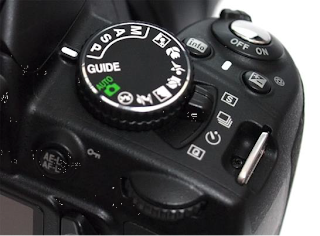Focus
The focus button on a camera allows the photographer to make the picture focus on a specific part. This could make the main focus clearer and sharper whilst the background is out of focus.
Aperature
This is the adjustment of the lens opening which is measured as an f'-number. This controls the amount of light that passes through the lens. The higher the f-number, the smaller the opening, the less light, the greater depth of field and the more diffraction blur. On DSLR cameras they have specific settings that mean different things. This is picture of the settings you can get:

The dial A means Aperature Priority.
This is a setting that allows the person using the camera to choose a specific aperure value and then the camera selects a perfect shutter speed to match which creates the perfect exposure. The main purpose of using this is to be able to control the depth of field. This is mainly used in landscape and portait photography since using a wide aperature gives you the opportunity to make the background seem out of focus and have the closest object appear really sharp and clear.
Shutter speed
This is the adjustment of the speed of the shutter which controls how fast or slow you can press the shutter button. Shutter speed may be used to control the amount of light striking the image plane; 'faster' shutter speeds decrease both the amount of light and the amount of image blurring from motion of the subject and/or camera.
When setting
the shutter speed on the DSLR, you choose the TV which means time value
on the dial. The camera will then calculate the appropriate aperture for
the correct exposure shown in the view finder.
There are 10 options for slow shutter speeds:
- 1/1000
- 1/500
- 1/250
- 1/125
- 1/60
- 1/30
- 1/15
- 1/8
- 1/4
- 1/2
All of them are in fractions of a second.
Long shutter speeds are done in whole seconds:
- 1
- 2
- 4
- 8
- 16
- 32
- 60
White balance
White balancing adjusts the camera for the type of light or lighting conditions in the scene so it will look normal to the human eye.
ISO speed
A measure of a film’s sensitivity to light. A 400 speed film is more sensitive to light than a 100 speed film. The fastre the film is makes it better in low light conditions. The ISO (International Organization for Standardization) give state of the art specifications for products, services and good practice. This helps the industry by making things more efficient and effective.
This is a picture of the founders of the ISO pictured in London in 1946:
This is a picture of a high ISO vs low ISO using a DLSR camera:
There is a major difference between these images, the low
ISO of 100 is blurry and unclear,
which doesn't really make it look like an appealing photography.
However, the high ISO of 800 uses depth of field to make the object closest to the camera stand out more.The background is supposed to be blurry on that picture as it makes the main theme stand out more.
ISO is the
level of light your camera lets in.. The lower the
ISO number the less sensitive your camera is to light, whereas the
higher the ISO number it increases the sensitivity of your camera which
creates a lot better of a photograph.
Autofocus point
This is a function on a camera that allows it to autofocus on the main subject of the photograph. The makes it so it doesn't look blurry in the wrong places.

I think you've mistaken ISO with aperture levels. When ISO is increased, there is increased sensitivity to light, meaning you can use faster shutter speeds or smaller apertures, but the photo will appear much more grainy. Low ISOs result in photos that are smoother and sharper, not more blurry, therefore producing a much more attractive photo.
ReplyDelete